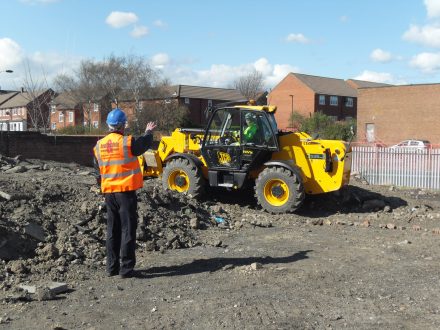Slinger Signaller Hand Signals
The job of a slinger signaller is one of the most important jobs on a building site. It requires skill, diligence, and concentration, working alongside the lifting teams to provide safe direction and supervision to the crane operators. Their main responsibility is to ensure the safety of the operators, and any other workers or site visitors that could be at risk.
View the official Slinger / Signaller hand signals below:
 The slinger signaller will act as the eyes and ears of the crane operator, who is likely to have an obstructed view of their surroundings. This obstructed view increases the risks involved with loading, lifting and generally operating the crane and so they need the slinger signaller to communicate via a series of hand signals to assist with manoeuvres.
The slinger signaller will act as the eyes and ears of the crane operator, who is likely to have an obstructed view of their surroundings. This obstructed view increases the risks involved with loading, lifting and generally operating the crane and so they need the slinger signaller to communicate via a series of hand signals to assist with manoeuvres.
The standard hand signals used by slinger signallers are detailed in the Health and Safety (Signs and Signals) Regulations 1996 L64.
They must be:
- Precise
- Clear
- Easy to make
- Easy to understand
In some situations these hand signals will not be sufficient to maintain a safe working environment and more signals will need to be used. If this happens, the signaller must only use signals that have been pre-arranged with the operator.
If weather conditions, such as fog, heavy rain or poor light, result in obscured viewing of the signaller, hi-visibility clothing, and items such as reflective armbands and signalling bats should be used to ensure a clear view of the signals.
If this isn’t sufficient, the slinger signaller has the authority to suspend the operation until they feel it is safe to resume.
Slinger/Signaller Training
As with any job that involves work equipment, slinger signallers must be trained to the required leghttps://www.hst.uk.com/mobile-plant-training/slinger-signalleral levels and competent to carry out their job safely and effectively.
Their training must be comprehensive and thorough, and should provide the learner with a full understanding of:
- The regulations affecting their job
- The operational requirements of the lifting task
- The features and safe use of the equipment and machinery
- The legal responsibilities of a slinger signaller
- The main causes of accidents and how to prevent them
- The correct procedures for manoeuvring equipment
- The approved and pre-arranged hand signals for communication
In 2013/2014, 16 workers suffered a fatal workplace injury resulting from an accident involving a workplace vehicle – this accounted for around 12.5% of all fatal workplace accidents.
As such, the role of a slinger/signaller is essential on all sites and is highly valued by employers and co-workers alike because of the high level of risk involved with the job they do.
Health and Safety Training Ltd
Still want to learn more about working with cranes, we recommend taking a look at these two articles.
To find out more about working as a slinger signaller, or to arrange training for yourself or a member of your staff – simply get in touch with the team at Health and Safety Training Ltd. With years of experience providing tailored training to suit a whole host of different requirements we can ensure you or your employees have the knowledge they need to effectively and safely direct lifting operations on your site.
Do You Have What it Takes to Become a Forklift Driver? How to Avoid Exposure to Silica





